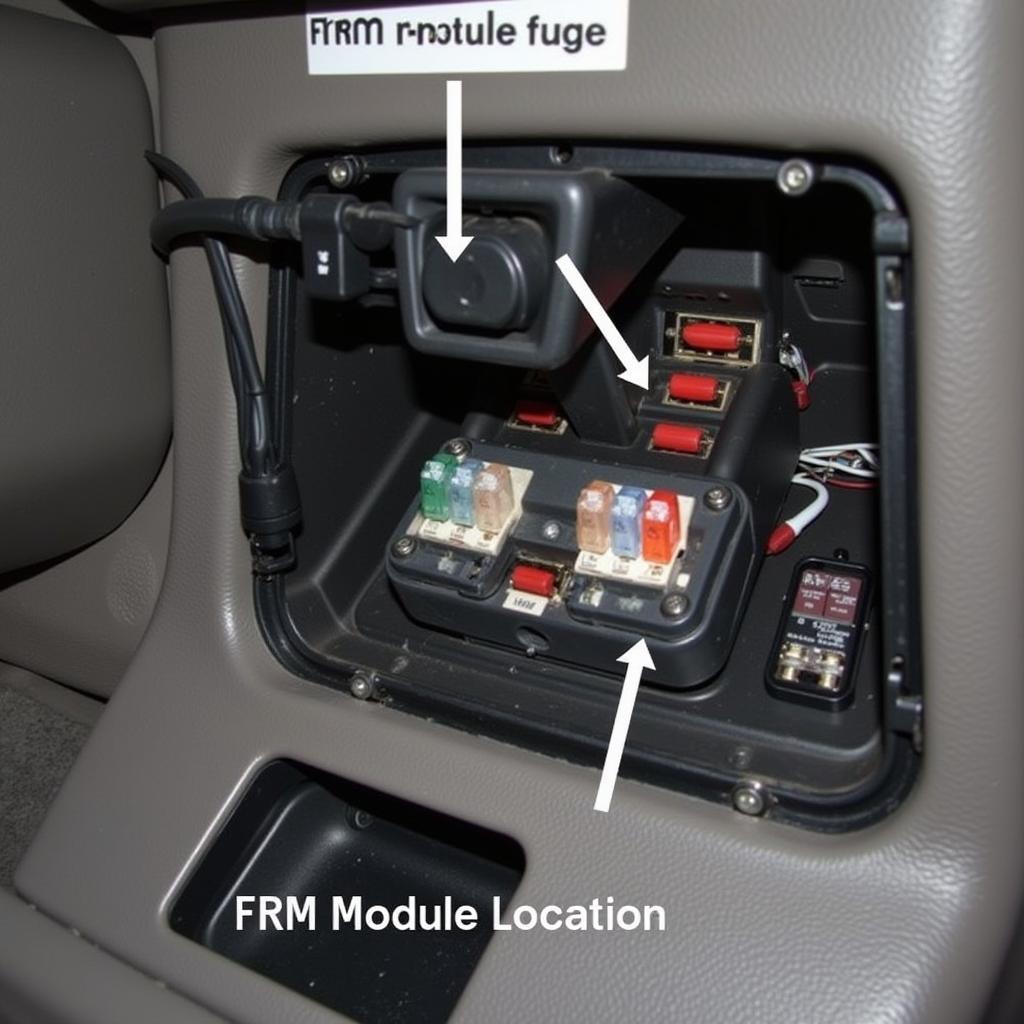The BMW E90, a popular model produced from 2004 to 2012, is known for its performance and luxury. However, like any vehicle, it can experience electrical issues, specifically with the Footwell Module (FRM). If your E90 displays symptoms like malfunctioning windows, exterior lights, or central locking, you might be facing problems with the FRM 70 or FRM 89 module. This article will delve into the reasons behind these issues and explore the solutions available to get your BMW back in top shape.
Decoding the FRM: The Brain Behind Your BMW’s Comfort Features
The FRM, often referred to as the Footwell Module, acts as the central control unit for various comfort and convenience features in your BMW E90. It’s responsible for managing:
- Exterior Lighting: Headlights, taillights, turn signals, and fog lights
- Interior Lighting: Ambient lights, reading lights, and footwell lights
- Window Control: Power windows, one-touch up/down functionality
- Mirrors: Power adjustment, folding, and heating functions
- Central Locking System: Locking/unlocking doors and the trunk
- Rain Sensors: Automatic wiper activation
- Alarm System: Arming and disarming the alarm
FRM 70 vs. FRM 89: Understanding the Difference
The terms “FRM 70” and “FRM 89” refer to different hardware versions of the Footwell Module used in the BMW E90. While they essentially perform the same functions, they have slight variations in their design and software.
It’s crucial to determine which version your E90 has before attempting any repair or replacement. This information can be found on the module itself or through diagnostic scanning.
Why Do FRM Issues Occur in BMW E90s?
Several factors can contribute to FRM 70 or FRM 89 issues in your BMW E90:
- Water Damage: The FRM is typically located beneath the dashboard, making it susceptible to water damage from leaks or spills.
- Power Surges: Voltage fluctuations, often caused by faulty batteries or jump-starting, can damage the sensitive electronics within the FRM.
- Software Corruption: Issues with the FRM’s software, potentially due to improper coding or failed updates, can lead to malfunctions.
- Component Failure: Over time, components within the FRM itself can wear out or fail, causing operational problems.
Common Symptoms of a Faulty FRM
Identifying FRM issues early can save you from potential headaches and costly repairs. Look out for these common symptoms:
- Windows malfunction: Windows may not roll up or down correctly, or at all.
- Lighting issues: Exterior lights like headlights, taillights, or turn signals might flicker, stay on permanently, or not function.
- Central locking problems: Doors may not lock or unlock using the remote or the interior switch.
- Battery drain: A faulty FRM can constantly draw power from the battery even when the car is off, leading to a dead battery.
- Error messages: Your dashboard may display warnings related to specific features controlled by the FRM, such as “bulb out” warnings even if the bulbs are working.
Diagnosing FRM 70 or FRM 89 Problems
Accurately diagnosing the root cause of FRM issues is essential before attempting any repair. Here’s how to pinpoint the problem:
- Visual Inspection: Begin by visually inspecting the FRM for any signs of physical damage, corrosion, or water ingress.
- Diagnostic Scanning: Use a BMW-compatible diagnostic scanner to read fault codes stored in the FRM. These codes provide valuable insights into the specific areas of concern.
- Component Testing: Depending on the symptoms and fault codes, you may need to test individual components related to the FRM, such as window motors, light bulbs, and wiring harnesses.
Exploring Solutions: Repair, Replace, or Reprogram?
Once you’ve diagnosed the FRM issue, you have several options:
- Repair: In some cases, it might be possible to repair the FRM by replacing damaged components or resoldering connections. However, this requires specialized knowledge and skills in electronics repair.
- Replacement: If the FRM is severely damaged or beyond repair, replacement with a new or used unit is often the most practical solution.
- Reprogramming: For software-related issues, reprogramming the FRM with updated or corrected software might resolve the problems. This typically requires specialized equipment and software.
Seeking Professional Assistance: When to Call in the Experts
While some FRM issues might be addressed with basic DIY skills, it’s often best to seek professional assistance, especially for complex problems or if you’re uncomfortable working with automotive electronics.
Cardiagtech specializes in remote diagnostics, programming, and software installation for BMW vehicles, including FRM issues. Our team of expert technicians can remotely access your vehicle’s computer system, diagnose the problem, and provide effective solutions tailored to your specific needs.
Contact Cardiagtech today for expert assistance with your BMW E90’s FRM issues!
Phone: +1 (641) 206-8880
Email: CARDIAGTECH[email protected]
Office: 276 Reock St, City of Orange, NJ 07050, United States
FAQs About BMW E90 FRM Issues
1. Can I drive my BMW E90 with a faulty FRM?
It’s not recommended. A faulty FRM can cause unexpected behavior in critical systems like lighting and central locking, compromising safety.
2. How much does it cost to replace an FRM in a BMW E90?
The cost varies depending on whether you choose a new or used module and labor charges. Contact us for a personalized quote.
3. Can a faulty FRM drain my BMW E90’s battery?
Yes, a faulty FRM can draw a parasitic current even when the car is off, leading to battery drain.
4. How long does it take to reprogram a BMW E90 FRM?
Reprogramming time can vary depending on the complexity of the software and the equipment used.
5. Can I prevent FRM issues in my BMW E90?
While not all issues are preventable, addressing water leaks promptly, avoiding jump-starting unless absolutely necessary, and keeping your vehicle’s software updated can minimize risks.

